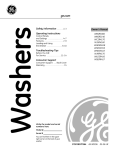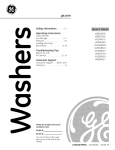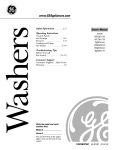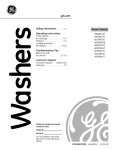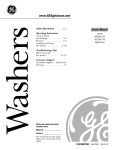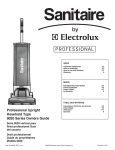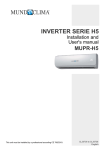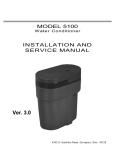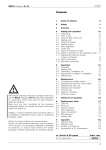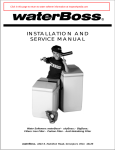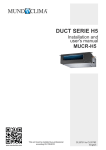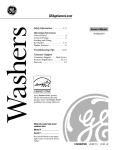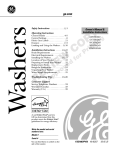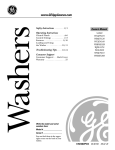Download GE WCSR4170 User's Manual
Transcript
Washers www.GEAppliances.com Safety Information . . . . . . . 2, 3 Operating Instructions Control Panels and Settings . . . . . . . . . . . . . 4–7 Features . . . . . . . . . . . . . . . . .7, 8 Loading and Using the Washer . . . . . . . . . . . . . .9, 10 Troubleshooting Tips Before You Call For Service . . . . . . . . . . . . 11–14 Owner’s Manual WBSR3140 WCSR4170 WJSR4160 WHDRR418 WHDSR315 WHDSR417 WJRR4170 Consumer Support Consumer Support . . Back Cover Warranty . . . . . . . . . . . . . . . . . 15 Write the model and serial numbers here: Model # __________________ Serial # __________________ You can find them in the upper right corner on the back of your washer. 175D1807P482 49-90212 08-04 JR Safety Instructions IMPORTANT SAFETY INFORMATION. READ ALL INSTRUCTIONS BEFORE USING. WARNING! For your safety, the information in this manual must be followed to minimize the risk of fire or explosion, electric shock, or to prevent property damage, personal injury, or loss of life. WATER HEATER SAFETY Under certain conditions hydrogen gas may be produced in a water heater that has not been used for two weeks or more. Hydrogen gas can be explosive under these circumstances. Operating Instructions If the hot water has not been used for two weeks or more, prevent the possibility of damage or injury by turning on all hot water faucets and allowing them to run for several minutes. Do this before using any electrical appliance which is connected to the hot water system. This simple procedure will allow any built-up hydrogen gas to escape. Since the gas is flammable, do not smoke or use an open flame or appliance during this process. PROPER INSTALLATION This washer must be properly installed and located in accordance with the Installation Instructions before it is used. If you did not receive an Installation Instructions sheet, you can receive one by visiting www.GEAppliances.com, or by calling 800.GE.CARES (800.432.2737). ■ Install or store where it will not be exposed to temperatures below freezing or exposed to the weather, which could cause permanent damage and invalidate the warranty. ■ Properly ground washer to conform with all governing codes and ordinances. Follow details in Installation Instructions. YOUR LAUNDRY AREA Troubleshooting Tips ■ Keep the area underneath and around your Consumer Support appliances free of combustible materials such as lint, paper, rags, chemicals, etc. 2 ■ Close supervision is necessary if this appliance is used by or near children. Do not allow children to play on, with or inside this or any other appliance. www.GEAppliances.com Safety Instructions WHEN USING THE WASHER Use this appliance only for its intended purpose as described in this Owner’s Manual. ■ Never reach into washer while it is moving. Wait until the machine has completely stopped before opening the lid. ■ Do not mix chlorine bleach with ammonia or acids such as vinegar and/or rust remover. Mixing different chemicals can produce a toxic gas which may cause death. ■ To minimize the possibility of electric shock, unplug this appliance from the power supply or disconnect the washer at the household distribution panel by removing the fuse or switching off the circuit breaker before attempting any maintenance or cleaning. NOTE: Turning the Cycle Selector knob to an off position does NOT disconnect the appliance from the power supply. ■ Never attempt to operate this appliance if it is damaged, malfunctioning, partially disassembled, or has missing or broken parts, including a damaged cord or plug. WHEN NOT IN USE ■ Do not attempt to repair or replace any part of this appliance unless specifically recommended in this Owner’s Manual, or in published userrepair instructions that you understand and have the skills to carry out. ■ Before discarding a washer, or removing it from service, remove the washer lid to prevent children from hiding inside. ■ Do not tamper with controls. Troubleshooting Tips ■ Turn off water faucets to relieve pressure on hoses and valves and to minimize leakage if a break or rupture should occur. Check the condition of the fill hoses; they should be replaced every 5 years. Operating Instructions ■ Do not wash or dry articles that have been cleaned in, washed in, soaked in or spotted with combustible or explosive substances (such as wax, oil, paint, gasoline, degreasers, dry-cleaning solvents, kerosene, etc.). These substances give off vapors that may ignite or explode. Do not add these substances to the wash water. Do not use or place these substances around your washer or dryer during operation. ■ The laundry process can reduce the flame retardancy of fabrics. To avoid such a result, carefully follow the garment manufacturer’s wash and care instructions. READ AND FOLLOW THIS SAFETY INFORMATION CAREFULLY. SAVE THESE INSTRUCTIONS Consumer Support 3 About the washer control panel. You can locate your model number on the back of your washer. • Add detergent • Add diluted fabric softener (on models with a fabric softener dispenser) Model WBSR3140 Model WCSR4170 4 • Add clothes • Select load size and other wash options • Select wash cycle Quick Start Guide • Close lid • Pull knob www.GEAppliances.com Model WJSR4160 Model WHDSR315 Model WHDSR417 Model WHDRR418 5 About the washer control panel. Model WJRR4170 Control settings. Load Size Loosely load clothes no higher than the top row of holes in the washer basket. The water level should just cover the clothes. Adjust the load size accordingly. Temperature Select the water temperature for the wash and rinse cycles. Always follow fabric manufacturer’s care label or instructions when laundering. Wash Cycle The wash cycle controls the length of the washing process. The chart below will help you match the wash cycle setting with your clothing. COTTONS For heavy to lightly soiled cottons, household linens, work and play clothes. EASY CARE For wrinkle-free and permanent press items, and knits. DELICATES For lingerie and special-care fabrics with light to normal soil. POWER WASH For heavily soiled and heavy-duty fabrics. This cycle provides a longer agitation. POWER RINSE Provides an automatic, second deep rinse to thoroughly remove detergent or bleach from your clothes. 15 MIN/30 MIN For very soiled clothes. Begins with a brief agitation, soaks for a specified period of time, then moves through the rest AUTO SOAK of the cycle automatically. PREWASH Use to wash heavily soiled clothes twice with detergent in each cycle. Automatically advances into the COTTONS wash cycle. To deliver extra detergent: Liquid Detergent–Place in fabric softener dispenser for use in second wash. DO NOT use dispenser for fabric softener. Powder Detergent–Place extra detergent in tub for use in first wash (approximately 11⁄2 times normal amount recommended). 6 About the washer features. NOTE: Not all features are available on all washer models. www.GEAppliances.com Safety Instructions 2nd Rinse Option (on some models) When you use extra detergent or bleach to clean heavily soiled clothes, you may want to use the 2nd Rinse option. It provides a second deep cold rinse. On some models, this option can be found on the cycle selector knob. The Agitator Cap or Fabric Softener Dispenser (depending on model) 3 Add water to dispenser until it reaches the maximum fill line. Operating Instructions The agitator cap fits into the top of the agitator. If it accidentally comes off, simply put it back on. The fabric softener dispenser automatically releases liquid fabric softener at the proper time during the cycle. Do not stop the washer during the first spin. This will cause the dispenser to empty too soon. To use, follow these steps: 1 Make sure dispenser is securely attached to agitator. 2 Use only liquid fabric softener. Pour into dispenser, using amount recommended on package. Do not pour anything into the agitator if the agitator cap or dispenser is removed. Troubleshooting Tips Never pour fabric softener directly on clothes. It may stain them. Consumer Support 7 About the washer features. Safety Instructions NOTE: Not all features are available on all washer models. Cleaning the Fabric Softener Dispenser (on some models) 1 2 Remove the dispenser from the top of the agitator. 3 To clean the dispenser, soak both the dispenser cup and the dispenser cover in the following solution: ■ 1 US gallon (3.8 liters) warm water ■ 1/4 cup (60 ml) heavy duty liquid detergent ■ 1 cup (240 ml) bleach Separate for cleaning. Operating Instructions Separate the dispenser cup from the cover by grasping the top and pushing down on the inside of the cup with your fingers. Dispenser cup will pop free from the cover. 4 If necessary, loosen buildup with a clean, soft cloth after soaking. Do not use a stiff brush; you may roughen the surface of the dispenser. 5 Rinse and reassemble dispenser. Place dispenser back on the agitator. Liquid Bleach Dispenser (on some models) The dispenser dilutes liquid chlorine bleach before it reaches your wash load. 1 2 Check clothing care labels for special instructions. Measure liquid bleach carefully, following instructions on the bottle. ■ Never pour undiluted liquid chlorine bleach directly onto clothes or into the wash basket. ■ Do not pour powdered bleach into bleach dispenser. Troubleshooting Tips 3 Before starting the washer, pour measured amount of bleach directly into bleach dispenser. Avoid splashing or over-filling dispenser. If you prefer to use powdered bleach, add it into the wash basket with your detergent. ■ Do not mix chlorine bleach with ammonia or acids such as vinegar and/or rust remover. Consumer Support Mixing can produce a toxic gas which may cause death. 8 Loading and using the washer. Always follow fabric manufacturer’s care label when laundering. www.GEAppliances.com Safety Instructions Sorting Wash Loads Sort by color (whites, lights, colors), soil level, fabric type (sturdy cottons, easy care, delicates) and whether the fabric produces lint (terry cloth, chenille) or collects lint (velveteen, corduroy). Proper Use of Detergent You can use less detergent if you have soft water, a smaller load or a lightly soiled load. Operating Instructions Add detergent and start the washer before adding clothes so that the detergent can work effectively. Using too little or too much detergent is a common cause of laundry problems. Loading the Washer Load dry items loosely, no higher than the top row of holes in the washer basket. When loading wet items make sure you set the load/water level high enough to allow the items to move freely. Water level should just cover the clothes. To add items after washer has started, push in Cycle knob and submerge additional items next to the agitator. Close the lid and pull Cycle knob out to restart. ■ Do not wrap long items like sheets or pants around the agitator. ■ Do not wash fabrics containing flammable materials (waxes, cleaning fluids, etc.). ■ Agitation will not start with the lid up. Troubleshooting Tips Consumer Support 9 Safety Instructions Loading and using the washer. Always follow fabric manufacturer’s care label when laundering. Care and Cleaning of the Washer Wash Basket: Leave the lid open after washing to allow moisture to evaporate. If you want to clean the basket, use a clean soft cloth dampened with liquid detergent, then rinse. (Do not use harsh or gritty cleaners.) Moving and Storage: Ask the service technician to remove water from drain pump and hoses. See the Installation Instructions packed with product for information on how to reinstall the shipping rod to keep the tub stationary when moving the washer. For more information, visit www.GEAppliances.com, or call 800.GE.CARES (800.432.2737). Do not store the washer where it will be exposed to the weather. Fill Hoses: Hoses connecting washer to faucet should be replaced every 5 years. Operating Instructions Exterior: Immediately wipe off any spills. Wipe with damp cloth. Try not to hit surface with sharp objects. Long Vacations: Be sure water supply is shut off at faucets. Drain all water from hoses if weather will be below freezing. Fabric Care Labels Below are fabric care label “symbols” that affect the clothing you will be laundering. WASH LABELS Machine wash cycle Normal Troubleshooting Tips Water temperature Permanent Press/ wrinkle resistant Hot (50°C/120°F) Gentle/ delicate Hand wash Warm (40°C/105°F) Do not wash Do not wring Cold/cool (30°C/85°F) DRY LABELS Tumble dry Dry Normal Permanent Press/ wrinkle resistant Gentle/ delicate High Medium Low No heat/air Do not tumble dry Do not dry (used with do not wash) Heat setting Consumer Support Special instructions Line dry/ hang to dry Drip dry Dry flat BLEACH LABELS Bleach symbols 10 Any bleach (when needed) Only non-chlorine bleach (when needed) Do not bleach In the shade Before you call for service… www.GEAppliances.com Safety Instructions Troubleshooting Tips Save time and money! Review the charts on the following pages, or visit www.GEAppliances.com. You may not need to call for service. WATER Too many suds Water leaks What To Do Type of detergent • Switch to a lower sudsing detergent brand and follow instructions on package. Soft water • Try less detergent. Too much detergent • Measure your detergent carefully. Use less soap if you have soft water, a smaller load or a lightly soiled load. Fill hoses or drain hose is improperly connected • Make sure hose connections are tight at faucets and rubber washers are installed. Make sure end of drain hose is correctly inserted in and secured to drain facility. The drain hose should be inserted into the washer and the collar or clip should be screwed in. Remove any kinks from the drain hose. Make sure that the hose connection is not strained when the washer is pushed close to the wall. Household drain may be clogged • Check household plumbing. You may need to call a plumber. Constant water pressure to the fill • Tighten hoses at the faucets and turn the water off after hoses at the water source each use. Operating Instructions Possible Causes • Check condition of the fill hoses; they should be replaced every 5 years. Fill hoses, washers and screens • Check that the rubber washers and screens have been installed correctly. Fill hoses, washers and screens should be replaced every 5 years. Overloading the washer • Loosely load clothes no higher than the top row of holes in the washer basket. The level of the water should be just above the clothes. Cooler water temperatures provide • New laundry detergents have been formulated to improved energy efficiency work with cooler water temperatures without affecting wash performance. Control is not set properly • Check water temperature control (on some models) or Cycle knob and adjust. Water supply is turned off or improperly connected • Turn both hot and cold faucets fully on and make sure hoses are connected to correct faucets. Water valve screens are stopped up • Turn off the water source and remove the water connection hoses from the upper back of the washer. Use a brush or toothpick to clean the screens in the machine. Reconnect the hoses and turn the water back on. House water heater is not set properly • Make sure house water heater is delivering water at 120°F–140°F (48°C–60°C). Drain hose is kinked or improperly connected • Straighten drain hose and make sure washer is not sitting on it. • Top of drain outlet should be less than 8 ft. (2.5 m) above floor. 11 Consumer Support Water won’t drain • Use less detergent. Use less soap if you have soft water, a smaller load or a lightly soiled load. Troubleshooting Tips Water temperature eems incorrect Using too much detergent in washer WATER Possible Causes What To Do Siphoning • If your standpipe or drain for the washer is less than 3 feet off the floor, the water will drain from the tub while it is filling. Lifting the drain hose at least 3 feet off the floor will allow the water to remain in the tub until the pump drains it out. The anti-siphon clip will lift the drain hose high enough to do this. The anti-siphon clip is included with the installation parts package for your washer. • Another way siphoning can occur is if the standpipe is stuffed with rags or other items that prevent air from escaping with the water. Air flow is needed to break the suction. • Check to make sure only the straight part of the drain hose is inserted into the standpipe; no ribs of the drain hose should be in the standpipe or drain pipe. • The washer drain must be 3 feet or more off of the floor to prevent the washer from draining during fill. If your washer drain is less than 3 feet above the floor, use the anti-siphon clip shipped with your washer to attach the drain hose to the back of your washer. The clip will hold the drain hose in place and ensure that the washer does not self-drain during fill. See installation instructions for details. • Only the straight top portion of the drain hose should be inserted into the drain. Inserting the ribbed section of the hose may create a siphon, and cause the washer to drain as it fills. • If the drain opening is excessively tight around the drain hose, or if the opening around the hose is closed with rags or other material, a siphon may occur, and the washer will drain as it fills. To avoid this problem, ensure that there is open area around the end of the drain hose to allow air to flow into the drain as water is pumped out of the washer. Possible Causes What To Do Washer pauses during spin cycle This is normal • The washer may pause during the spin cycle to remove soapy water more efficiently. Washer won’t operate Washer is unplugged • Make sure cord is plugged securely into a working outlet. Water supply is turned off • Turn both hot and cold faucets fully on. Controls are not set properly • Check controls and make sure Cycle knob is pulled out to ON position. Lid is open—safety feature prevents agitation and spinning when lid is up • Close lid and reset cycle, to the beginning if necessary. Circuit breaker/fuse is tripped/blown • Check house circuit breakers/fuses. Replace fuses or reset breaker. Washer should have separate outlet. Possible Causes What To Do Incorrect use of fabric softener • Check fabric softener package for instructions and follow directions for using dispenser. • Pretreat stain and rewash. Dye transfer • Sort whites or lightly colored items from dark colors. Water fills and drains at the same time Consumer Support Troubleshooting Tips Operating Instructions Safety Instructions Before you call for service… OPERATION PERFORMANCE Colored spots 12 www.GEAppliances.com Grayed or yellowed clothes Possible Causes What To Do Not enough detergent • Use more detergent (especially with larger loads). Be sure to follow detergent manufacturer’s directions. Hard water • Use a water conditioner like Calgon brand or install a water softener. Water is not hot enough • Make sure water heater is delivering water at 120°F–140°F (48°C–60°C). Washer is overloaded • Select load size to match clothes load. Detergent is not dissolving • Add detergent as wash basket fills with water before you load clothes. Dye transfer • Sort clothes by color. If fabric label states wash separately, unstable dyes may be indicated. Clothes are air or line dried • If you do not dry your clothes with a clothes dryer, your clothes may retain more lint. Incorrect sorting • Separate lint producers from lint collectors. Washing too long • Wash small loads for a shorter time than larger loads. Detergent not dissolving • Add detergent as wash basket fills with water, before you load clothes. • Try a liquid detergent. Operating Instructions Lint or residue on clothes Safety Instructions PERFORMANCE (cont.) • Use warmer water temperature. Overloading • Load clothes no higher than the top row of holes in the washer basket. • Make sure load size selected matches clothes load size. • Check fabric softener package for instructions and follow directions for using dispenser. Pilling Result of normal wear on poly-cotton blends and fuzzy fabrics • While this is not caused by the washer, you can slow the pilling process by washing garments inside out. Snags, holes, tears, rips or excessive wear Pins, snaps, hooks, sharp buttons, belt buckles, zippers and sharp objects left in pockets • Fasten snaps, hooks, buttons and zippers. • Turn knits (which snag easily) inside out. Undiluted chlorine bleach • Check bleach package instructions for proper amount. • Never add undiluted bleach to wash or allow clothes to come in contact with undiluted bleach. Chemicals like hair bleach or dye, permanent wave solution • Rinse items that may have chemicals on them before washing. Improper sorting • Avoid mixing heavy items (like work clothes) with light items (like blouses). Consumer Support Wrinkling • Remove loose items like pins, objects in pockets and sharp buttons. • Try a fabric softener. Overloading or incorrect water level • Load your washer so clothes have enough room to move freely with water covering all of the clothes. Incorrect wash and dry cycles • Match Cycle selection to the type of fabric you are washing (especially for easy care loads). Repeated washing in water that is too hot • Wash in warm or cold water. Troubleshooting Tips Incorrect use of fabric softener 13 NOISE Washer is noisy Operating Instructions Safety Instructions Before you call for service… Possible Causes What To Do Washer is uneven • To level the front of the washer, adjust the front leveling legs by rotating the individual leg in the proper direction for up or down. To level back of washer, lift back of machine 4″ (11 cm) and set down. Washer load is unbalanced • Push the Cycle knob in to stop the washer, open the lid and redistribute the load evenly. Close the lid and restart. Shipping rod is still assembled in unit • To remove shipping rod from washer, pull yellow tag and attached rod from the bottom right hand side of washer. Washer is sitting too close to wall (causes knocking during cycle) • Pull washer away from the wall; about 4″ (11 cm) is needed. Whistle or knock during fill • Normal sounds during fill include the water filling in through the house plumbing. As the water pressure goes up and down, a knock or hammer can develop. Make sure the water faucets are fully turned on. Clanking or clunking • Many washers have features such as pulse agitation and pauses during rinse and spin for reduced clothes wear and to reduce likelihood of soap residue. These short pauses of less than 1 minute are normal and will reduce clothing wear and increase water extraction. Sounds such as a metallic knock, double knock or metallic clunk occur when the washer transitions from a stop or paused state to running or spinning. They occur several times per cycle after speed changes or pauses. Troubleshooting Tips • Normal sounds during fill include the sound of water flowing through your hosehold pipes. Additionally, a knock, or hammering sound may also occur when the washer water valves turn off. To reduce this noise, make sure that the washer fill faucets are fully opened. • Your washer will pause between the various wash, rinse, spin and drain portions of the wash cycle. It may also pause during agitation if a Pulsed Agitation cycle is selected. Sounds such as metallic knocks or clinking may occur during these transitions from running to stopped or from stopped to running. They may also occur if your machine changes speeds or brakes during a wash cycle. OTHER Consumer Support Labels on the exterior of the washer will not peel off cleanly 14 Possible Causes What To Do Occasionally the adhesive used on the labels does not release cleanly • Use a hair dryer set at the lowest heat setting, directing the air at the label for a short amount of time. This will release the adhesive easily, without damaging the surface of the washer. GE Washer Warranty. Staple your receipt here. Proof of the original purchase date is needed to obtain service under the warranty. We Will Replace: One Year From the date of the original purchase Any part of the washer which fails due to a defect in materials or workmanship. During this full one-year warranty, we will also provide, free of charge, all labor and related service to replace the defective part. Second through Fifth Year From the date of the original purchase The transmission, suspension rod and spring assembly if any of these parts should fail due to a defect in materials or workmanship. GE will also replace the washer lid or cover, if they should rust under operating conditions. During this additional four-year limited warranty, you will be responsible for any labor or related service costs. Second through Tenth Year From the date of the original purchase The washer tub, if it should fail due to a defect in materials or workmanship. During this additional nine-year limited warranty, you will be responsible for any labor or related service costs. Second through Twentieth Year From the date of the original purchase The washer basket, if it should fail due to a defect in materials or workmanship. During this additional nineteen-year limited warranty, you will be responsible for any labor or related service costs. Operating Instructions For The Period Of: Safety Instructions All warranty service provided by our Factory Service Centers, or an authorized Customer Care® technician. To schedule service, on-line, 24 hours a day, visit us at www.GEAppliances.com, or call 800.GE.CARES (800.432.2737). What Is Not Covered: ■ Service trips to your home to teach you how to use ■ ■ ■ ■ Damage to the product caused by accident, fire, floods or acts of God. ■ Incidental or consequential damage caused by possible defects with this appliance. ■ Defects or damage due to operation in freezing temperatures. ■ Damage caused after delivery. This warranty is extended to the original purchaser and any succeeding owner for products purchased for home use within the USA. In Alaska, the warranty excludes the cost of shipping or service calls to your home. Troubleshooting Tips ■ the product. Improper installation, delivery or maintenance. Failure of the product if it is abused, misused, or used for other than the intended purpose or used commercially. Replacement of house fuses or resetting of circuit breakers. Products which are not defective or broken, or which are working as described in the Owner’s Manual. Some states do not allow the exclusion or limitation of incidental or consequential damages. This warranty gives you specific legal rights, and you may also have other rights which vary from state to state. To know what your legal rights are, consult your local or state consumer affairs office or your state’s Attorney General. Consumer Support Warrantor: General Electric Company. Louisville, KY 40225 15 Consumer Support. GE Appliances Website www.GEAppliances.com Have a question or need assistance with your appliance? Try the GE Appliances Website 24 hours a day, any day of the year! For greater convenience and faster service, you can now download Owner’s Manuals, order parts, catalogs, or even schedule service on-line. You can also “Ask Our Team of Experts™” your questions, and so much more... Schedule Service www.GEAppliances.com Expert GE repair service is only one step away from your door. Get on-line and schedule your service at your convenience 24 hours any day of the year! Or call 800.GE.CARES (800.432.2737) during normal business hours. Real Life Design Studio www.GEAppliances.com GE supports the Universal Design concept—products, services and environments that can be used by people of all ages, sizes and capabilities. We recognize the need to design for a wide range of physical and mental abilities and impairments. For details of GE’s Universal Design applications, including kitchen design ideas for people with disabilities, check out our Website today. For the hearing impaired, please call 800.TDD.GEAC (800.833.4322). Extended Warranties www.GEAppliances.com Purchase a GE extended warranty and learn about special discounts that are available while your warranty is still in effect. You can purchase it on-line anytime, or call 800.626.2224 during normal business hours. GE Consumer Home Services will still be there after your warranty expires. Parts and Accessories www.GEAppliances.com Individuals qualified to service their own appliances can have parts or accessories sent directly to their homes (VISA, MasterCard and Discover cards are accepted). Order on-line today, 24 hours every day or by phone at 800.626.2002 during normal business hours. Instructions contained in this manual cover procedures to be performed by any user. Other servicing generally should be referred to qualified service personnel. Caution must be exercised, since improper servicing may cause unsafe operation. Contact Us www.GEAppliances.com If you are not satisfied with the service you receive from GE, contact us on our Website with all the details including your phone number, or write to: General Manager, Customer Relations GE Appliances, Appliance Park Louisville, KY 40225 Register Your Appliance www.GEAppliances.com Register your new appliance on-line—at your convenience! Timely product registration will allow for enhanced communication and prompt service under the terms of your warranty, should the need arise. You may also mail in the pre-printed registration card included in the packing material. Printed in the United States
















